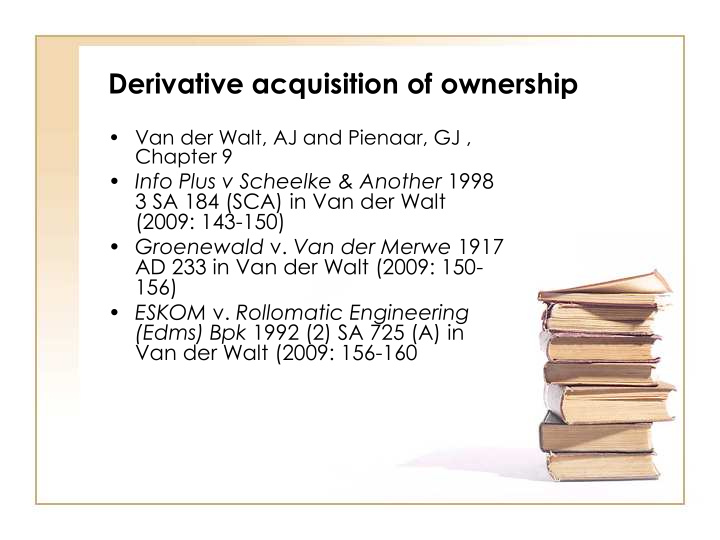



Derivative acquisition of ownership • Van der Walt, AJ and Pienaar, GJ , Chapter 9 • Info Plus v Scheelke & Another 1998 3 SA 184 (SCA) in Van der Walt (2009: 143-150) • Groenewald v. Van der Merwe 1917 AD 233 in Van der Walt (2009: 150- 156) • ESKOM v. Rollomatic Engineering (Edms) Bpk 1992 (2) SA 725 (A) in Van der Walt (2009: 156-160
Learning outcomes of this unit: After completion of this Unit the learner will be able to: • Explain what is meant by derivative acquisition of ownership, and distinguish it from original acquisition of ownership. • Name and explain the requirements for transfer of ownership. • Identify what the difference between a causal and an abstract system of transfer of ownership is. • List the requirements for payment of the purchase price in the case of cash sales and credit sales, respectively.
Learning outcomes of this unit: (continued) • Distinguish between the different forms of transfer. • Illustrate how constructive transfer takes place. • Sketch what the requirements for constitutum possessorium are and why this form of transfer is applied with caution. • Interpret the application of attornment is in practice. • Solve problems regarding the different forms of transfer of ownership. • Note how transfer of ownership of immovable things takes place.
DERIVATIVE ACQUISITION OF OWNERSHIP • Requirements Concor Construction (Cape) (Pty) Ltd v Santambank Ltd p125 • Causal or abstract system – p126 • Cash and Credit sales – p127
DELIVERY (Traditio) • Commissioner of Customs and Excise v Randles Brothers and Hudson – Traditio vera (actual delivery) • DEFINITION • REQUIREMENTS – Constructive delivery ( Traditio ficta ) • DEFINITION • REQUIREMENTS • REGISTRATION
Forms of Constructive Delivery • Clavium traditio – Definition – Examples • Traditio longa manu (delivery with the long hand) - Groenewald v Van der Merwe – Definition – Requirements – Eskom v Rollomatic Engineering (Edms) Bpk
Forms of Constructive Delivery (Continued) • Traditio brevi manu (with short hand) – Definition – Already in control of transferee, change in intention – Examples • Constitutum possessorium – Definition – Remains in control of transferor, but change in intention – Examples – Requirements – NB: Note danger of simulated transactions!!!! • Re-leasing agreements • Quenty’s Motors -case p 134
Forms of Constructive Delivery (Continued 2) • Attornment • Definition • Control by 3rd party, change on whose behalf he holds • Example • Discounting transaction - Barclays Western Bank Ltd v Ernst -ABSA Bank Ltd v Myburgh • Requirements • Caledon en Suid-Westelike Distrikte Eksekuteurskamer Bpk v. Wentzel 1972 (1) 270 (A)
Registration (read only) • Publicity principle • Positive vs Negative registration system • Registration procedure
Homework activity • Name the requirements for delivery with the long hand ( traditio longa manu ). Refer to case law. • Discuss the requirements for attornment with reference to applicable case law. • Which system of transfer of ownership is followed in South African law? Discuss. • Fully discuss the requirements for transfer of ownership according to the derivative method .
Homework activity (continued) • The defendant and a third party D signed a document declaring that D had sold a threshing machine to the defendant and received payment for it. Defendant (V) after inspecting the machine, left it with D upon the understanding that D should keep and use it until asked for it. A year later D sold the same machine, which was still in his possession, to the plaintiff and once again a document was signed to declare that the machine was paid for and that it could be delivered to the plaintiff immediately.
Homework activity (continued) • The plaintiff accompanied D to his farm, inspected the machine and declared that it was now his. Before delivery could take place the defendant removed the machine and eventually the plaintiff sued the defendant for recovery of the machine and damages. Will the plaintiff be successful with the claim? Discuss and in your answer refer to relevant case law. – Legal question – Ratio – Application
Recommend
More recommend